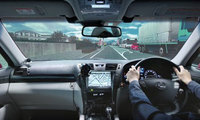Toyota engineers build world’s biggest “Playstation”
 Toyota has unveiled a massive driving simulator, designed to safely analyse driving characteristics and so develop improved active safety technology.
Toyota has unveiled a massive driving simulator, designed to safely analyse driving characteristics and so develop improved active safety technology.The driving simulator, located at Toyota’s Higashifuji Technical Centre in Japan, provides one of the world’s most-realistic simulated driving environments, allowing driving habits and reactions to be accurately gauged.
Key to this virtual reality is the use of a real car placed on a platform housed inside a 7.1-metre-diameter dome, the inside of which serves as a giant 360-degree video screen.
As the driver operates the vehicle, a tilt mechanism, vibration apparatus and other devices manipulate the dome, which can be moved around an area the equivalent of four tennis courts, under precision computer control.
The result is a true simulation of the actual sensation of driving, including a sense of speed, acceleration and riding comfort through turns and other driving manoeuvres. Sound effects make the experience even more real.
The driving simulator is no toy. It will mainly be used to analyse driving characteristics under such conditions as falling asleep at the wheel and drowsiness, glancing from side to side and not checking that the road is safe, fatigue or illness, as well as developing active safety technology for effectively reducing the number of accidents.
Toyota’s stated long term aim is to produce cars that never crash and the company plans to put the driving simulator to full use in advancing R&D, not only for on-board vehicle safety systems, but also for systems that support safe driving practices and integrate cars with the road infrastructure.
Driving Simulator Specifications
Dome size: Height: 4.5m; diameter: 7.1m
Dome mobility: Max. 35m lengthways, 20m sideways
Dome tilt: Max. 25 degrees
Level of vibration: Max. variation of 50mm up or down
Sensation of speed: Max. 0.5G
Turntable rotation: Max. 330 degrees in either direction
Rumours that Toyota engineers have plugged the latest version of Gran Turismo into the simulator are unconfirmed.






